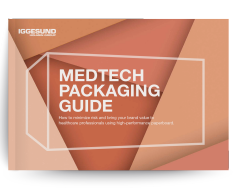Change. It’s the one word that manufacturers of medical devices have a love-hate relationship with. On the one hand, their future depends on new therapeutic technologies that are safer, less invasive, improve patient outcome and drive down costs. And yet even small modifications to an existing device or packaging system may necessitate a whole new validation process requiring a minimum of a year to complete and costing hundreds of thousands of euros. This challenge was made clear to Iggesund Paperboard for a drug-coated balloon packaging in which a board upgrade was under consideration.
Clean and premium box
“The customer basically told us ‘please don’t change anything right now,’” says Ian Huskinson, a technical service manager at Iggesund Paperboard who is based in the UK. He adds that Invercote G had been recommended by a well-respected converter due to its ability to create a smooth, clean, premium-feeling box with good printability. The box in question, which is roughly A4 sized and 15-20 mm deep with a tuck-in flap, contains an insert tray where the catheter is placed, covered in a sealed plastic pouch. To accommodate their needs, Iggesund developed a contingency solution with a bespoke product. “This situation really underscored to us how important product longevity and consistency, in terms of packaging materials, are to our customers,” says Huskinson. “Product consistency from batch to batch is absolutely critical – no changes at all – and that applies to the entire product life cycle as well as an uninterrupted and guaranteed supply chain over many years. This is really a top priority for us.”
Easy to use and fully compliant
“In this case, the actual technical requirements of the carton, in terms of the shape, were not extremely challenging, but the customer also had an extensive list of quality assurance requirements for risk reduction,” he says. “Their QA parameters include everything from packaging sterilization, permeability and transport to ease-of-use demands in the catheter labs of hospitals. Invercote G is fully compliant with all FDA requirements and has been successfully validated by the customer for ethylene oxide (EtO) sterilization, gamma irradiation and more.”
Drug-coated balloons
The drug-coated balloon (DCB) is a new type of minimally invasive intravascular catheter used by cardiovascular surgeons to reduce or eliminate blockage in blood vessels and arteries. It emits a chemical agent that helps to reduce deposits on the wall of the artery and shortens the need for additional procedures for a period of up to four years. It has been shown to deliver safe and consistent results, particularly in the onset of peripheral artery disease as well as other indications.
"Product consistency from batch to batch is absolutely critical – no changes at all – and that applies to the entire product life cycle as well as an uninterrupted and guaranteed supply chain to multiple European production sites over many years. This is really a top priority for our customers."
Ian Huskinson, Technical Service Manager Iggesund Paperboard
A competitive market
The need for such novel devices is growing in parallel with the rise of aging populations, the prevalence of diabetes and high intake of fatty foods in general – all of which contribute to the blockage or narrowing of blood vessels and arteries (atherosclerosis). But according to a series of studies by iData MedTrack, the DCB catheter space, while growing, is fiercely competitive, meaning that leading device manufacturers are under pressure to prove efficacy in patient outcome, pharma-economic benefits and also promote their brand difference to healthcare professionals.
Standing out on hospital shelves
“Clearly, the packaging of a device sitting on a hospital storage shelf does not have the same need for design effects that a branded product closer to consumer use might have, but it still needs to look professional and promote ease of use. Customers want to convey a sense of quality that matches the premium quality of their own products,” says Ian Huskinson. “There are a lot of different catheters on the market, so there is a need to differentiate your brand even in the operating theatre – something that nurses and surgeons can be sensitive to as well.”
Download MedTech Packaging Guide
Get expert advice, avoid common mistakes and see how leading MedTech companies are thriving with paperboard packaging.
Click to download for free.

High sterilization requirements
According to Huskinson, the proven ability of Invercote to work smoothly and consistently in the sterilization process was also a key factor. In the customer’s cleanroom, the boxes are double and triple-checked for packaging integrity, cleanliness and purity. The packaging is preconditioned at a temperature of 54°C with humidity levels ranging between 30 and 90% for a period of approximately 12–17 hours. The filled boxes are then flushed with ethylene oxide gas to kill any bacterial culture that may appear, in accordance with the ISO 11135 standard.
Safe, durable and consistent
“When you are selling a novel device that stands for safety, durability and consistency, you need to be sure that the packaging material lives up to this as well,” says Huskinson. He notes that Iggesund meets all of the relevant ISO certifications and can secure data from its entire supply chain.
Risk minimization in every step
“Their team of toxicologists was very happy that we could provide detailed information regarding the chemical composition of our board to safeguard any theoretical impurity issues. It was a transparent exchange of information and constructive discussion from both sides to meet mutually beneficial goals. At the end of the day, we all want to minimize risk by securing the integrity of the product – every step of the way,” he concludes.


